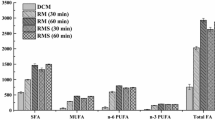Abstract
The quantitative determination of the total free fatty acids (FFAs) is an important analytical task because FFAs exhibit important physiological effects and are also relevant in many other fields, for instance, in food research. Our aim was to investigate whether a commercially available enzymatic test kit developed for the determination of FFAs in human serum is also suitable to determine different physiological and nonphysiological FFAs and to which extent the impact on the sensitivities (i.e., the accuracy by which a given FFA can be determined) differ. It will be shown that the chain length as well as the double bond content has a significant impact on the sensitivity by which a given FFA can be determined. For instance, palmitic acid (16:0) is determined with an approximately 20 times higher sensitivity in comparison to docosahexaenoic acid (22:6n-3). All data were obtained by measuring the concentrations of the FFAs by gas chromatography, and selected FFAs were also determined in a complex matrix of human serum. It is concluded that this kit is not useful if major alterations of the FFA composition of a complex mixture are expected because the individual FFAs are not detected with the same sensitivities: the concentrations of polyunsaturated FFA determined by this kit are wrong.

The used enzymatic kit detects different free fatty acids with significantly different sensitivities: the number of carbon atoms and the number of double bonds massively contribute to these differences



Similar content being viewed by others
References
Donnelly KL, Smith CI, Schwarzenberg SJ, Jessurun J, Boldt MD, Parks EJ (2005) Sources of fatty acids stored in liver and secreted via lipoproteins in patients with non-alcoholic fatty liver disease. J Clin Investig 115:1343–1351
Eibisch M, Riemer T, Fuchs B, Schiller J (2013) Differently saturated fatty acids can be differentiated by 31P NMR subsequent to derivatization with 2-chloro-4,4,5,5-tetramethyldioxaphospholane: a cautionary note. J Agric Food Chem 61:2696–2700
Nikolova-Damyanova B, Momchilova S (2001) Silver ion thin-layer chromatography of fatty acids. A survey. J Liq Chromatogr Rel Technol 24:1447–1466
Griffiths WJ (2003) Tandem mass spectrometry in the study of fatty acids, bile acids, and steroids. Mass Spectrom Rev 22:81–152
Yang WC, Adamec F, Regnier FE (2007) Enhancement of the LC/MS analysis of fatty acids through derivatization and stable isotope coding. Anal Chem 79:5150–5157
Shroff R, Svatoš A (2009) 1,8-Bis(dimethylamino)naphthalene: a novel superbasic matrix for matrix-assisted laser desorption/ionization time-of-flight mass spectrometric analysis of fatty acids. Rapid Commun Mass Spectrom 23:2380–2382
Eibisch M, Süss R, Schiller J (2012) Time-dependent intensity changes of free fatty acids detected by matrix-assisted laser desorption and ionization time-of-flight mass spectrometry in the presence of 1,8-bis(dimethylamino)naphthalene—a cautionary note. Rapid Commun Mass Spectrom 26:1573–1576
Blank EW (1962) Errors in the acid and saponification values of fatty acids. J Am Oil Chem Soc 39:122–123
Omar F, van der Watt G, November V, Pillay TS (2010) Plasma free fatty acid reference interval in South African neonates in the first week of life. Ann Clin Biochem 47:381–382
McGowan MW, Artiss JD, Strandbergh DR, Zak B (1983) A peroxidase-coupled method for the colorimetric deterrmination of serum triglycerides. Clin Chem 29:538–542
Shimizu S, Tani Y, Yamada H, Tabata M, Murachi T (1980) Enzymatic determination of serum-free fatty acids: a colorimetric method. Anal Biochem 107:193–198
Bligh EG, Dyer WJ (1959) A rapid method of total lipid extraction and purification. Can J Biochem Physiol 37:911–917
Dannenberger D, Nuernberg K, Nuernberg G, Priepke A (2012) Different dietary protein and PUFA interventions alter the fatty acid concentrations, but not the meat quality, of porcine muscle. Nutrients 4:1237–1246
Shen X, Dannenberger D, Nuernberg K, Nuernberg G, Zhao R (2011) Trans-18:1 and CLA isomers in rumen and duodenal digesta of bulls fed n-3 and n-6 PUFA-based diets. Lipids 46:831–841
Holmberg K, Jönsson B, Kronberg B, Lindman B (2003) Surfactants and polymers in aqueous solution. Wiley, Chichester
Ralston AW, Hoerr CW (1942) The solubilities of the normal saturated fatty acids. J Org Chem 7:546–555
Ralston AW, Hoerr CW (1952) The solubilities of oleic and linoleic acids in common organic solvents. J Org Chem 56:1068–1073
Wang DC, Sun CH, Liu LY, Sun XH, Jin XW, Song WL, Liu XQ, Wan XL (2012) Serum fatty acid profiles using GC-MS and multivariate statistical analysis: potential biomarkers of Alzheimer's disease. Neurobiol Aging 33:1057–1066
Shimizu S, Yasui K, Tani Y, Yamada H (1979) Acyl-CoA oxidase from Candida tropicalis. Biochem Biophys Res Commun 91:108–113
Acknowledgments
This work was supported by the Federal Ministry of Education and Research (BMBF Grant 0315735, Virtual Liver Network) and by the German Research Council (SFB 1052/B6).
Author information
Authors and Affiliations
Corresponding author
Rights and permissions
About this article
Cite this article
Eibisch, M., Popkova, Y., Süß, R. et al. Evaluation of a commercial enzymatic test kit regarding the quantitative analysis of different free fatty acids. Anal Bioanal Chem 406, 7401–7405 (2014). https://doi.org/10.1007/s00216-014-8162-4
Received:
Revised:
Accepted:
Published:
Issue Date:
DOI: https://doi.org/10.1007/s00216-014-8162-4




